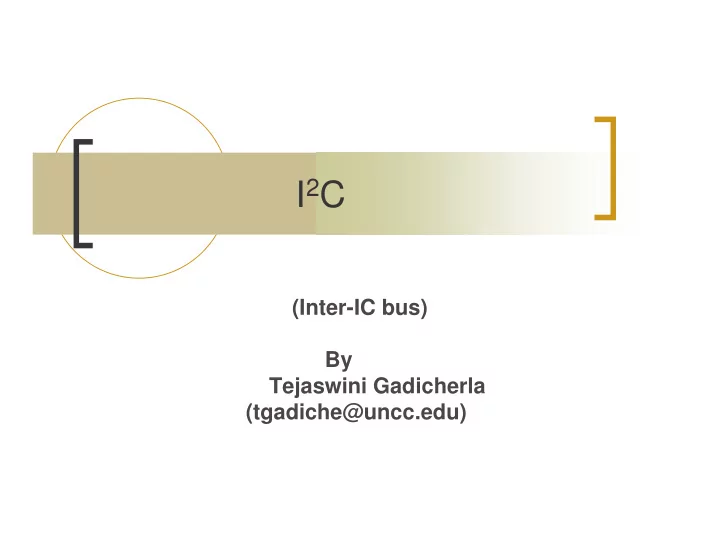

I 2 C (Inter-IC bus) By Tejaswini Gadicherla (tgadiche@uncc.edu)
Topics Discussed …. n What is I 2 C ??? n Why has it endured? n Bus transfer terminology n How does it work?
Introduction to I 2 C I 2 C is a control bus providing n communications link between integrated circuits in a system. Developed by Philips in the early 1980s. n Examples of I 2 C-compatible devices n found in embedded systems include EEPROMs, thermal sensors and real-time clock.
Why I2C has endured? Bus has kept pace with performance n and today offers 3 levels of data transfer rate 100kbps in standard mode ¡ 400kbps in Fast mode ¡ 3.4 Mbps in high-speed mode ¡
Why I2C has endured? Reliable performance using software- n controlled collision detection and arbitration. n Ease of use. 2 lines connect all ICs in a system. n Software controlled addressing scheme eliminating need for address- decoding hardware.
What does I2C consist of? I2C is a 2 wire serial bus as shown above. The 2 signals are SDA � Serial Data SCL � Serial Clock Together these signals make it possible to support serial transmission.
I2C BUS The device that initiates the transaction on the I2C n bus is termed the master. The master normally controls the clock signal. A device being addressed by the master is called n the slave. There needs to be at least one master( a n microcontroller or a DSP) on the bus, but there can be more than one master. All the masters on a bus have equal priority.
Every device on the I2C bus has a n unique 7 bit (or 10 bit) I2C address. n Typically the 4 most significant bits are fixed and assigned to specific categories of devices. Ex: 1010 is assigned to serial EEPROM. n The lower 3 bits are programmable allowing 8 devices of one kind to be present on a single I2C bus.
Terminology for bus transfer SCL and SDA are bi-directional ! F(free) – Bus is idle or free. Both SDA and SCL are in a high � state S(Start) or R(Restart) – SDA changes from high to low with � the SCL line remaining high. All data transfers begin with S(Start) condition. C(Change) – SCL line is low. Data bit to be transferred is � applied to the SDA line. D(Data) – high or low bit of information on SDA line is valid � during the high level of the SCL line. P(Stop) – SDA line changes from low to high with SCL line � remaining high. All data transfers end with P(Stop) condition.
Data transfer • Data is transferred in sequences of 8 bits. •Bits are placed on SDA line with MSB first. •SCL line is then pulsed high and then low. •For every 8 bits transferred, the device receiving the data sends back an acknowledge bit.
Data transfer(contd) If the receiving device sends back an low ACK bit, n then it has received the data and is ready to accept another byte. If it sends back a high ACK, then the device is n indicating that it cannot accept any further data and the master should terminate the transfer by sending a stop sequence.
I2C device addressing All I2C devices are either 7 (or 10) bits. Yet we n send out 8 bits when trying to address a device. This extra bit is used to inform the slave whether n the master is writing to it or reading from it. The 7 bit address is placed in the upper 7 bit and n the R/W bit is placed in the LSB. So if LSB is 1, master wants to read from a slave. n Else if LSB is 0, master wants to write to a slave.
Writing to a slave device Master sends a start sequence. This alerts all the n slave devices to an impending transaction and they should listen , in case its for them. Next the master sends out the device address with n read/write bit low. The slave that matches this address will continue the transaction , while others ignore. Master can now send data byte(s). n Master sends the stop sequence. n
Reading from a slave Master sends a start sequence. n Master sends the device address with read/write bit high. n Master reads data from the device. n Master sends the stop sequence n
References n http://www.semiconductors.philips.com/m arkets/mms/protocols/i2c/facts/ n http://www.embedded.com/story/OEG200 10718S0073 n http://www.mcc-us.com/i2chowto.htm
Recommend
More recommend